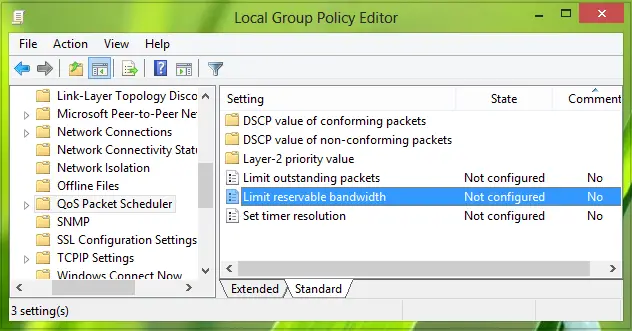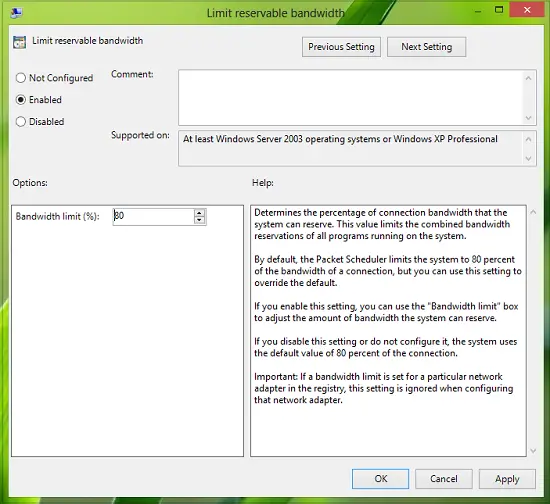In general, bandwidth is the rate at which data travels to and fro from your computer. In other words, bandwidth is the range covered for data transmission between an upper range and a lower range. Bandwidth is usually controlled by your Internet Service Provider (ISP). However, there exist some settings in Windows, by configuring which you limit the reservable bandwidth for your system.
Primarily, Windows reserves a certain amount of bandwidth for its application requirements and operation purposes. By configuring its setting in the Group Policy, you can easily limit the reservable bandwidth. This article will show you stepwise, how to access or open up the reservable bandwidth on your Windows 11/10/8.
Limit Reservable Bandwidth Setting in Windows 11/10
1. Press Windows Key + R combination, type put gpedit.msc in Run dialog box and hit Enter to open the Local Group Policy Editor. The Group Policy Editor, incidentally, is not available in Windows Home version. It is available only in Windows Pro, Enterprise, etc., versions,

2. Navigate here:
Computer Configuration -> Administrative -> Network -> Qos Packet Scheduler

3. In the right pane of this window, look for the settings named Limit reservable bandwidth, it must be showing a Not Configured status by default. Double click on the same setting to modify it:

This policy setting determines the percentage of connection bandwidth that the system can reserve. This value limits the combined bandwidth reservations of all programs running on the system. By default, the Packet Scheduler limits the system to 80 percent of the bandwidth of a connection, but you can use this setting to override the default. If you enable this setting, you can use the “Bandwidth limit” box to adjust the amount of bandwidth the system can reserve. If you disable this setting or do not configure it, the system uses the default value of 80 percent of the connection. If a bandwidth limit is set for a particular network adapter in the registry, this setting is ignored when configuring that network adapter.
4. Now, in the above-shown window, select Enabled and in the Options section; you could input the percentage for limiting the bandwidth. If you input 0 percent here, you can gain the reserved bandwidth reserved by the system. UPDATE: Do read the note below.
Click Apply, followed by OK then. You may now close the Local Group Policy Editor and reboot the system with gained bandwidth.
If your version of Windows does not ship with Gpedit, then you may open Regedit and navigate to the following registry key:
HKEY_LOCAL_MACHINE\SOFTWARE\Policies\Microsoft\Windows\Psched
Give it Value Data 0. If Psched does not exist, create it.
Hope you find the tip useful!
NOTE BY ADMIN:
The claim that Windows always reserves a percentage of the available bandwidth for QoS is incorrect. One hundred percent of the network bandwidth is available to be shared by all programs unless a program specifically requests priority bandwidth. This “reserved” bandwidth is still available to other programs unless the requesting program is sending data. If the program that reserved the bandwidth is not sending sufficient data to use it, the unused part of the reserved bandwidth is available for other data flows on the same host, says KB316666.
So what will happen if you change the limit of the reservable bandwidth to zero?
Here is what Microsoft has to say:
The Windows Operating System reserves a fixed percentage of the total Internet bandwidth for the QoS or Quality of Service usage like Windows update, license renewal, etc. Thus, when you limit the Reservable Bandwidth of the operating system to 0, this will affect the operating system activities like Automatic Windows Updates. If a QoS-aware application reserves more bandwidth than it uses, then the unused, reserved bandwidth is available for use by other applications. The reservation does not ensure that the bandwidth will be available to the QoS-aware application because applications that are not QoS-aware might consume too much bandwidth.
More details on TechNet.
What is using my bandwidth in Windows 11?
If you want to check bandwidth usage by devices in Windows 11, then you can track bandwidth usage with the help of your router. Log in with your credentials to access router settings and check for the option or setting that provides detailed data usage. You will be able to see a list of devices including sent packets, received packets, and other information. If you want, you can also use some best free bandwidth monitoring tools (like ISP Monitor, Cucusoft Net Guard, etc.) for Windows PC to check bandwidth and internet usage.
How do I fix limited bandwidth problems?
The best option to get rid of the limited bandwidth problem is by upgrading your internet plan to get a higher bandwidth limit. So, you need to contact your ISP for that. If you don’t want that, then you can increase your internet speed by limiting the connected devices, allowing your computer to receive more data with a Registry hack, performing a virus and malware scan, using an Ethernet cable, upgrading your router, etc.
Hope this helps.
Hello Kapil,
I just want to know if the leftover bandwidth gained means a faster internet speed.
Another thing, is this the same with Windows 7?
Thank you,
Ben
^^ Yup, since bandwidth is rate of flow of data, and it is directly proportional to speed. This works for Windows XP to 8.1; all Windows editions :)
Nice article, but you will not be able to use gpedit in any windows versions unless they are Business, Pro or Enterprise. Windows XP Home, Vista Home Premium, Windows 7 Starter/Home Basic/Home Premium and Windows 8/8.1 standard do not ship with the group policy editor and Local Security Policy MMCs but it’s possible to alter the registry if you can find the Qos Packet Scheduler key.
^^ You can create the DWORD NonBestEffortLimit at registry location HKEY_LOCAL_MACHINESOFTWAREPoliciesMicrosoftWindowsPsched and put its Value data 0 for gaining the reserved BW in the Windows editions you’ve mentioned so far :)
Are you sure that’s 100 the correct number ? can be 0 the correct number ?
seems to me that “reserved” bandwidth the correct number should logically be 0
^^ AFAIK, its 100 for GPO and 0 for REGEDIT :)
I’m sort of confused here? Is it 100% or 0%?
Conflicting websites ==> http://www.tecflap.com/2012/08/30/increase-internet-connection-speed-windows-8/
==> http://xtendedview.com/computer/windows-8/how-to-increase-the-internet-speed-in-windows-8/749/
Yet another one that further confuses the issue ==> http://forums.mydigitallife.info/threads/46358-The-difference-in-the-QoS-reservable-bandwith-between-Windows-7-and-Windows-8
On my Win8.1 system this setting is DISABLED which means that it is running at 80/20, but the field is set to a grayed out 0 and when ENABLED that is what it is set too. The above link sort of suggests W7 is different.
Hmmm, Yes – it does confusing – but I think it should be 0%. But will request the author to research and revert tomorrow. Thanks for posting the links.
I see you put a note in, thanks.
I went back and looked at my Windows Update History and I discovered KB2903939 failed to install since 12/24, so your comment helped me there as I was going to try Windows Update and happened to look at the History. I was able to fix it with DISM and the Troubleshooter, and did notice a lot of people had similar problems with that one when I searched the web on the error code?
Any way I did change the suggest change to 0 and then from your comment tried running Windows Update and that is how I discovered the problem. It was NOT related to the change as I made it today. What was odd was when I looked at that setting again, even though I ENABLED it and it was showing as 0 and saved it, when I went back it was set to 80?
From that I’ll assume 0 is not a legal number?
So I again DISABLED that setting.
I wonder if that setting is worth doing at all?
^^ What happens when you made it 100%? Does it allows the updates to be installed?
Kapil, I set GPEDIT setting to what I thought was 0. Then after Anand’s comment I was going to do a Windows Update to check. One Update was waiting, KB2903939, so I tried installing it. It FAILED! OK, let me see what the error was. I looked at the explanation link and basically it said to run the Troubleshooter and use DISM, basically the info posted here, https://www.thewindowsclub.com/checksur-system-update-readiness-tool. I did that, ‘scanhealth’ reported the error can be fixed than ran it with ‘restorehealth’. Retried, still failed. I then ran the Troubleshooter and it fixed some stuff… but it still failed. Looked at the log and this KB started failing on 12/24/13. Another update, my video driver failed the next day (at 5AM when the computer probably was not on) but succeeded later that afternoon. So Windows Update did work, just not that KB? I decided to re-boot and try again. Still failed. OK, I’ll reset GPEDIT and that is where I found the setting NOT to be 0 but 80? I suspect the troubleshooter (which said it was make Registry Changes, I wish I looked at the LOG file that was saved away but can’t find it now in TEMP) reset it. So I DISABLED the setting to be safe. Tried the KB again, still failed. Ran DISM again, and it found errors that could be reset… hmmm… and I ran the Troubleshooter and it too found errors it fixed…
Ran Update again and it now worked?
I’m not sure why this happened or if it was related to the setting or not as the problem existed with that specific KB for weeks. Suspect that is due to me creating a new restore image and then moving it as I did it in Dec.
Bottom line, I don’t know what the setting should be? All I now know is that if it is DISABLED I’m able to do the Update?
Which way makes it 100%, use 100 or 0 in GPEDIT or something else in the registry? It seems the reserved is just that, and if QoS is not active you are able to use it all anyway?
I’ve had a hard time quantifying this. I have a wired to the router system. On the router (1GB wire) is a USB 2.0 drive and the best speed I can get to it is 150Mbps or so. To my other computer which is connected wirelessly at 300Mbps I can get around 130Mbps to its hard drive, SATAIII. My hard drives are SATAII. I think via the wired connection to the router and the attached USB 2.0 drive I should be approaching 400Mbps?
How does one test throughput and calculate the theoretical limit? Without those data points hard to tell if this setting is useful or not?
^^ I have done bit more research on this and found that it should be 0% to disable reserved bandwidth. We have made appropriate correction to the article as well. Thanks for feedback :)
Ok now i understand
By setting the QoS to 0 it affects my download speed in torrents as well now i set it up to disable and the download speed has increased.
Psched dosen’t exist.
^^ You can manually create that subkey as well.
Is there any way you could give me step by step instructions on how to do that, I have 8.1.
bro i don’t see gpedit.msc , what do i do?
Start + Window + R + gpedit.msc = YES I DID IT !!
^^ Group Policy Editor is only available in Enterprise and Pro editions :)
hello please gpedit does exist in my windows 8.1
its says gpedit.msc make sure u typed the name correctly what to do
I cant double click or open Limit reservable bandwith. Anyone can help me??
Hi when try to run gpedit.mcs i get msg saying ” Windows cannot find it ”
I am running Win 8.1.. 64 bit
Maybe your version of Windows does not have it.
Limit Reservable Bandwidth Setting Doesn’t Really Help much
Well in your post here you said “gpedit.mcs” when it is “gpedit.msc” (msc not mcs).
cant we edit grppolicy in other versions of windows os
There is no GPEDIT.MSC in WINDOWS 8 !
Thanks a lot for the hint. Much less struggle in our family :)
There is no gpedit.msc on my windows 8.1
^^ Change the registry key mentioned after step 4.
kapil brother in my windows there is no gpedit what i should do bro
i tryed of thousand of times but isnt working for me :( (eternal 20% limit)
it not working for me. it’s not limit
Its just a myth.
Would like to know a technical reason for doing this … to my knowledge … this does not impede Internet speed… Internet speed is dictated by traffic on the server you are accessing … enabling this setting has no affect on this.. this is one of those supposed fallacies with windows…. you cannot change the speed of the Internet… Windows defaults are just fine… tweaking these are a myth…
it ses windows cant find it
I’m on a windows 10 yet I still can’t run it on RUN. Did I miss something? HELP!
great post has worked a treat thanks
Now is there similar policy thing for upload usage ???
hmm.. What if someone is trying to fix bufferbloat but can’t fix it on the router/modem end ? 80% or even 90% Qos within Windows itself would seem like an easy fix for buffering or am i wrong ? I have plenty of bandwidth and not worried about 10 % missing to compensate for bufferbloat.
As per the admin this post is useless and misleading.So why don’t you remove this post. You are wasting users time by configuring something that will not hep as per Microsoft